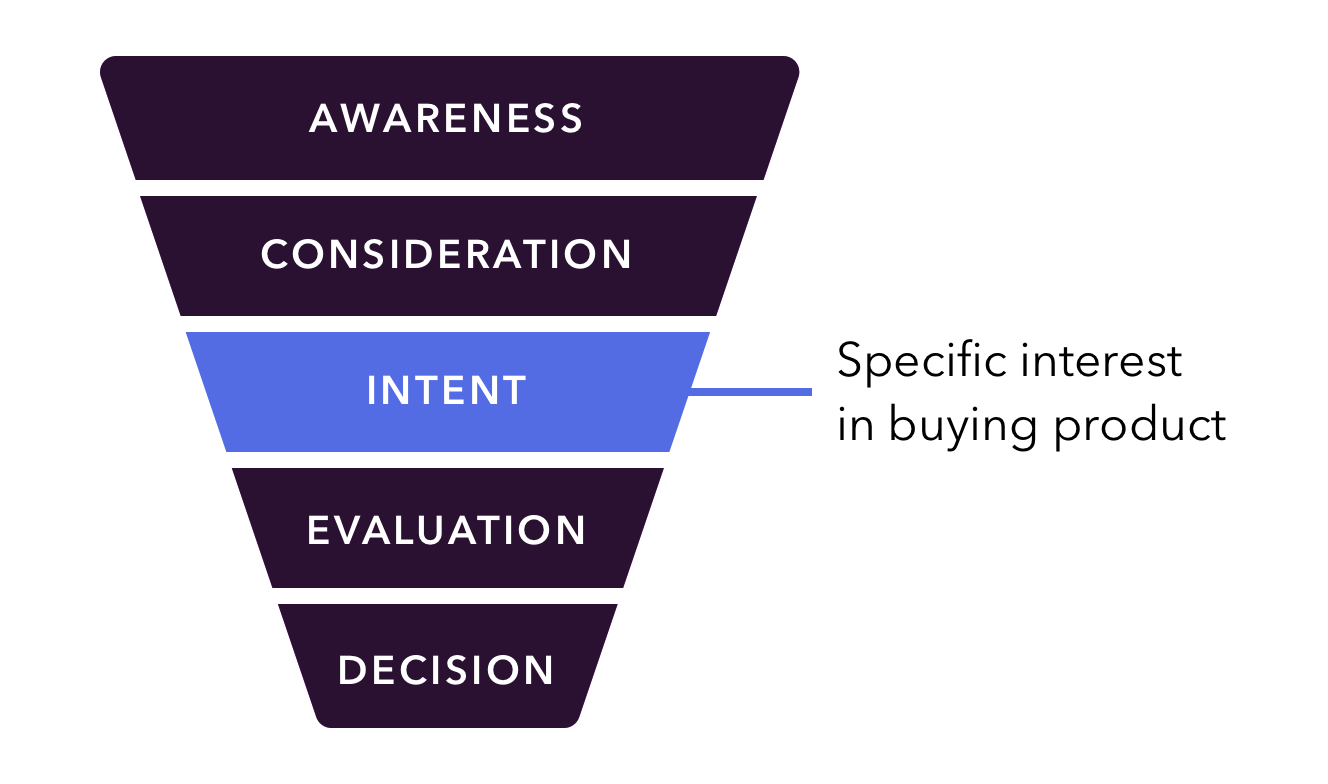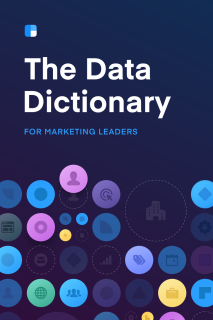Chapter 4
10 minutes
Intent: behavioral and contextual data
If fit data is all about whether you want a company or person to be your customer, then intent data is all about whether they want you back. ("Will you be my girlfriend? Circle Yes/No.")
Intent data helps answer questions about how ready a prospect is to actually buy — indicating how close they are to the "intent" stage of the buyer's journey. Prospects in this high-intent stage are seriously evaluating their options and are ready to pay for a solution to their problem.

Intent data can give marketers a lot of leverage, because when they know that a prospect is closer to purchasing, messages and CTAs can be less about awareness and more focused on encouraging action. Marketers can increase the intensity and frequency of outreach in the knowledge that doing so may be welcome rather than annoying, and they also have a bit more information to make that outreach helpful, which also helps with the annoying thing.
And detecting intent data early gives marketing and sales a head start because they can reach out a little earlier in the decision cycle…and maybe beat competitors to the punch.
We'll look at some examples soon of how to detect intent early in the B2B world. But for now, let's briefly review the two types of data that come together to inform the overall picture.
Intent signals come from behavioral data, which are the actions that a prospect takes in relation to your product or solution. Contextual data provides more nuance and understanding.
This data provides clues about the journey that prospects take to get to you — where they've "come from" when they step foot on your digital properties — and the broader context in which they research products and make purchase decisions.
Behavioral data
Behavioral data is the simple accounting of what people do, when they do it, and how often. In B2B, it refers to the way folks engage with your company, product, and marketing materials, from the pages they visit on your site to the webinars they attend to the way they interact with your product during a free trial.
Pay attention to these behaviors if you want to better understand your prospects. It's also useful to track behavioral data of existing customers to understand their engagement, happiness, and intent to purchase more.
Examples of behavioral data for prospects
Here are some common actions that you might track when looking at prospects' behavior:
- Website activity and visits to specific pages
- Signups and activity for free products and trial accounts
- Content downloads
- Webinar signups and attendance
- Blog post and case study views
- Email engagement
- Ad engagement
- Requests to talk to sales or receive a demo (also known as "hand raises")
- Responsiveness (e.g., going dark for six months then suddenly becoming responsive to sales outreach)
- Online research (e.g., visiting SaaS app review sites and researching similar solutions online)
And don't forget this! Marketers don't just want to track whether prospects take these specific actions. They also want to understand timing and frequency, as well as any patterns in their behavior. If a prospect only reads blog posts about a single topic, like "customer retention," and downloads only the customer retention ebook, that's good information that a marketer or salesperson can use to deduce which products this prospect might be interested in hearing more about and which customer stories might be most helpful to share.
Customer behavior is helpful to understand how a product is currently being used — and you probably already have tools or systems in place to track this data already. Beyond product usage, this data also provides actionable insights about customers, like whether they've adopted your product and are experiencing its full value. That's major! A happy customer is worth its weight in gold. (Well, if we're talking actual gold, maybe that depends whether it's SMB or enterprise.) Behavioral data can also indicate cross-sell and up-sell potential: whether they would be a fit for other features, products, and services that they don't have yet.
Examples of B2B behavioral data for current customers
- How do they actually use your product?
- What integrations have they activated?
- How frequently do they log in? Are they a MAU, a DAU, or some other frequency?
- How many people at the company are using your product? What is the rate of individual adoption? (Can you spread to new teams?)
- What other products of yours have they purchased, and which have they not?
- Are they interacting with ads/emails/marketing material for other products of yours, indicating cross-sell potential?
You can track these actions in aggregate to get insights about your entire customer base, or zoom in on one account to understand it individually.
But since behavioral data is just an accounting of people's actions, it's up to you to make meaning out of it and turn it into intent data to help determine purchase interest or cross-sell potential.
Interpret responsibly
Of course, it's important to interpret and act on behavioral data appropriately. Just because someone takes an action that's coded as high intent doesn't mean they're actually a good fit for your company's product. Many cases of misdirected B2B marketing can be attributed to a failed mapping of behavior to intent. And it's icky.
You might already be familiar with this. Imagine you're a recent engineering graduate and tomorrow you have a job interview at a SaaS company tomorrow that makes enterprise CRMs. Nervous much? You're a well-organized type, so you go to their blog to prepare for your interview — not to purchase their software — but you get bombarded with chat pop-ups inviting you to speak to salespeople. Afterward, retargeting ads follow you around the internet for the next two weeks.
It doesn't feel quite right. It's as if the company thinks they know you, but they couldn't be more wrong — and you couldn't be further away from actually purchasing anything, let alone being remotely interested or able to.
It also feels mismatched if you want to download a whitepaper for research purposes, but first you have to fill in a 10-field form about your "company" and "how many employees you have" — especially if you're not in any position to buy a solution. It's a strange set of hurdles to jump over that seem to have very little to do with reality.
It's cases like these that make people see marketing in a bad light: a misinterpretation of intent can lead to a certain over-familiarity that misses the mark.
This is why, as a marketer, it's important to think about how you're making meaning out of behavior. You should try to interpret a person's behaviors to see whether or not they exhibit purchase intent, and you should also take into account their firmographic data, demographic data, and contextual data — where they're coming from when they visit your website — to get a higher success rate and ensure that their experience makes sense.
Contextual data
Contextual data is background information about a visitor who comes to your website. (For the purposes of this discussion, we're focusing on site visits.) It explains what is unique about the visitor when they're on your website, providing clues about who they are and what they might be looking for.
And you can tailor your website content and experience to these contexts. This type of data is typically most actionable and useful toward the top of the funnel and for early customer acquisition, when visitors are researching and discovering the glory of your products.
Examples of contextual data:
- Referral source (what website a visitor came from before they landed on yours)
- Whether they came from a specific marketing campaign (with UTM parameters)
- New or returning visitor
- Device used: mobile or desktop
- Operating system (Android, iOS, etc.)
- Browser used
- Keyword searched on Google before clicking the link to your site
Contextual data is often available in web analytics tools, like Google Analytics, which tracks visitor referral sources and more through UTM parameters.
Referral sources, in particular, can be useful for marketers, because the more info you have about the channels your visitors came from, the more clues you have about purchase intent, where to reach future visitors, and what kind of content and tone to use when personalizing an experience for that visitor.
- Social media
- Blog posts from a specific topic category
- A webinar you've run
- Co-marketing activity on partner sites
- Product Hunt
- Emails
- Ads
- Search activity
- Product review sites and directories
Contextual data can help you personalize website experiences and generally understand broader patterns about the origins of visitors and customers, such as:
- Where do most of our site visitors come from?
- Where do our best customers typically come from?
- Does it make sense to speak to the customers who come from Channel A in one way and Channel B in another?
- Are they visiting our website on their mobile device or laptop, and do we need to therefore design our experience differently?
- When a great-fit prospect takes actions on our site that signal high purchase intent, what context are they typically coming from and are there patterns to learn from? Do they come from our webinars? From one powerful marketing campaign we spent a lot of money on? From a small set of blog posts? There are many possibilities to investigate.
For example, you might analyze your site traffic and learn that your best-fit visitors all come from a single partner site, so you might want to continue investing in this partner, or find look-alikes. Makes sense, right? Or maybe you drive traffic for a launch from Product Hunt and show a discount code for a hunt, which gives you context about the origin of those visitors. You can also personalize your landing page by taking the keyword that a visitor searched on Google—say, "CRMs for manufacturers"—and embed it in the headline.
The context of mobile-versus-desktop is also useful. A common problem in B2B marketing is that people love to browse, discover, and learn on their mobile devices, but they don't make big B2B purchases on their phones as often. (Or B2C, for that matter. Just a second, I'm buying a Salesforce plan and a Porsche on my iPhone…okay, back with you.) The challenge is to get that mobile visitor interested enough to re-engage on a desktop when they're in that "B2B mindset". Often, companies will design a mobile experience that supports discovery and simply captures an email address, and then they'll email the prospect later with more marketing materials that involve longer forms or sign-ups.
Typeform, a B2C and B2B survey company, once told us how they grappled with this exact issue. Their product was super viral on mobile, so they got a lot of website traffic through organic discovery on phones, but their prospects weren't likely to fill out a B2B lead form right then and there. Typeform began to look more closely at their mobile analytics platforms to get a sense of user flows and behavioral patterns, then started to invest in the mobile "learning and discovery" experience, thinking about how to change their website experience depending on whether a visitor was on a phone or their laptop.
By considering visitor context, you can personalize experiences and get a broader understanding of origins, patterns, and ROI to inform your marketing activities.
We've talked about behavioral and contextual data, and when we put them together they can help us find signals of purchase intent. Next, we'll go through how to understand and respond to activity indicating this purchase intent.

